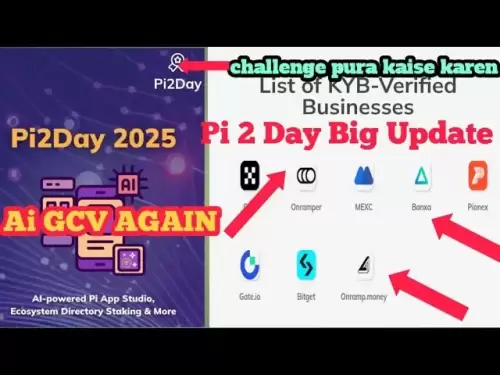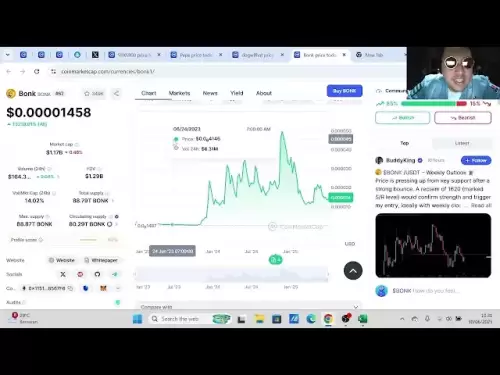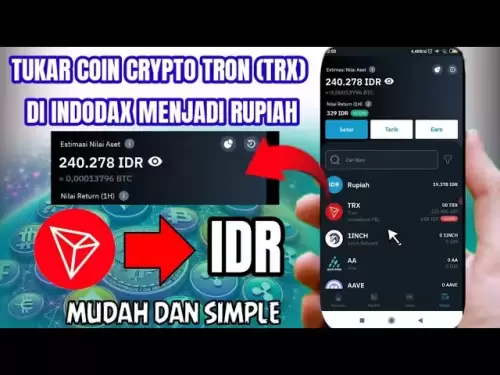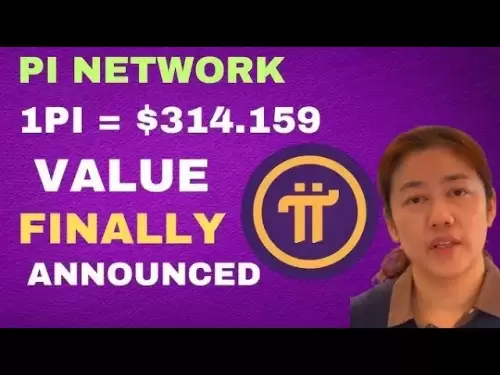-
 Bitcoin
Bitcoin $107,397.3430
-0.20% -
 Ethereum
Ethereum $2,467.5633
1.33% -
 Tether USDt
Tether USDt $1.0002
0.01% -
 XRP
XRP $2.1994
0.71% -
 BNB
BNB $655.8723
1.07% -
 Solana
Solana $157.3780
4.63% -
 USDC
USDC $1.0000
0.02% -
 TRON
TRON $0.2792
1.23% -
 Dogecoin
Dogecoin $0.1645
0.50% -
 Cardano
Cardano $0.5666
1.83% -
 Hyperliquid
Hyperliquid $39.8730
3.91% -
 Bitcoin Cash
Bitcoin Cash $514.7673
5.02% -
 Sui
Sui $2.7969
-0.51% -
 Chainlink
Chainlink $13.2880
0.07% -
 UNUS SED LEO
UNUS SED LEO $9.1148
-0.60% -
 Avalanche
Avalanche $17.9247
0.34% -
 Stellar
Stellar $0.2351
-0.98% -
 Toncoin
Toncoin $2.9456
2.69% -
 Shiba Inu
Shiba Inu $0.0...01144
-0.74% -
 Litecoin
Litecoin $85.9064
-0.62% -
 Hedera
Hedera $0.1495
1.47% -
 Monero
Monero $319.0339
3.82% -
 Polkadot
Polkadot $3.3940
-0.40% -
 Dai
Dai $1.0000
0.01% -
 Ethena USDe
Ethena USDe $1.0003
0.00% -
 Bitget Token
Bitget Token $4.5223
-1.95% -
 Uniswap
Uniswap $7.1384
-0.02% -
 Aave
Aave $272.7534
0.72% -
 Pepe
Pepe $0.0...09836
2.57% -
 Pi
Pi $0.5107
-2.06%
SOL coin analysis: discussion on future potential and investment value
Solana's high-speed PoH mechanism offers scalability but faces centralization concerns. High SOL price volatility presents risk and reward, while regulatory uncertainty adds further complexity to its investment potential.
Mar 13, 2025 at 09:46 pm
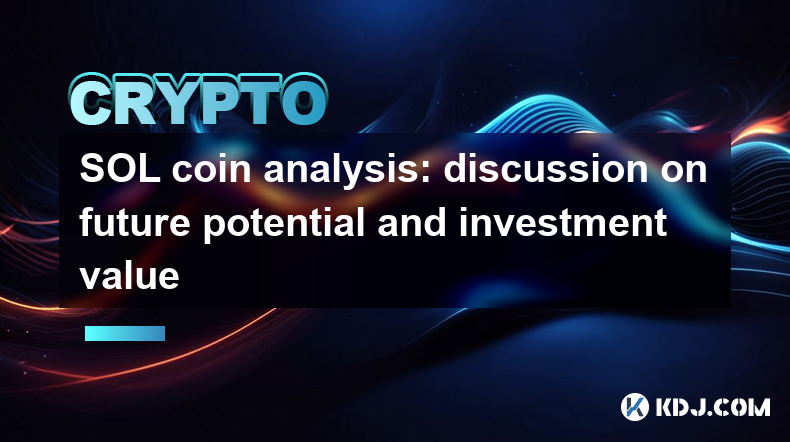
Key Points:
- Solana's innovative consensus mechanism, Proof-of-History (PoH), offers potential for high transaction speeds and scalability. However, its centralization concerns remain a point of contention.
- SOL's price volatility is significant, presenting both high-risk and high-reward scenarios for investors. Past performance is not indicative of future results.
- The Solana ecosystem boasts a growing DeFi landscape and NFT marketplace, yet faces competition from established players like Ethereum.
- Regulatory uncertainty surrounding cryptocurrencies globally poses a risk to SOL's future value.
- Thorough due diligence and risk assessment are crucial before investing in SOL or any cryptocurrency.
SOL Coin Analysis: Discussion on Future Potential and Investment Value
Solana (SOL) has emerged as a prominent player in the cryptocurrency space, attracting attention for its purported speed and scalability. However, its future potential and investment value remain subjects of ongoing debate. This analysis delves into various aspects to provide a comprehensive overview.
Solana's Technological Advantages and Limitations:
Solana's core innovation lies in its Proof-of-History (PoH) consensus mechanism. PoH aims to significantly improve transaction throughput compared to traditional blockchains like Bitcoin or Ethereum. This theoretically allows for faster transaction processing and lower fees, attracting developers and users. However, concerns remain about the degree of centralization inherent in the PoH system, potentially impacting its decentralization claims and long-term security. The network's vulnerability to outages has also raised questions about its reliability.
Scalability and Ecosystem Development:
Solana's high transaction speeds have attracted developers building decentralized applications (dApps) within its ecosystem. The Solana ecosystem hosts a growing number of DeFi projects, offering users various lending, borrowing, and trading opportunities. Furthermore, Solana supports the creation and trading of Non-Fungible Tokens (NFTs), contributing to its growing community. However, it faces stiff competition from established players like Ethereum, which possesses a larger, more mature ecosystem and network effect.
Price Volatility and Investment Risk:
SOL's price has exhibited significant volatility, mirroring the broader cryptocurrency market's inherent risk. While this volatility offers potential for substantial returns, it also presents considerable downside risk. Past performance should not be taken as an indicator of future price movements. Investors should carefully assess their risk tolerance before considering any investment in SOL.
Regulatory Landscape and Future Outlook:
The regulatory landscape for cryptocurrencies remains uncertain globally. Changes in regulations could significantly impact the price and adoption of SOL. Governments worldwide are grappling with how to regulate crypto assets, and any future regulations could either stifle or boost the growth of the Solana ecosystem. The future of SOL, therefore, is heavily dependent on the evolving regulatory environment.
Factors Affecting SOL's Investment Value:
Several factors influence SOL's investment value. These include:
- Technological advancements: Further developments and improvements to the Solana network, addressing scalability and security concerns, could positively impact its value.
- Ecosystem growth: An increase in the number of dApps, users, and developers within the Solana ecosystem can boost demand for SOL.
- Market sentiment: Overall market sentiment towards cryptocurrencies and Solana in particular can significantly influence SOL's price.
- Competition: The competitive landscape, particularly from Ethereum and other Layer-1 blockchains, will play a crucial role in shaping SOL's future.
Step-by-Step Guide to Researching SOL Investment (Illustrative):
- Understand the technology: Research Solana's Proof-of-History consensus mechanism and its implications.
- Analyze the ecosystem: Explore the dApps and projects built on Solana.
- Assess the competition: Compare Solana to other blockchain platforms.
- Review price history: Study SOL's price charts and historical volatility.
- Consider regulatory risks: Research the regulatory landscape for cryptocurrencies.
Frequently Asked Questions:
Q: Is Solana a good long-term investment?
A: Whether Solana is a good long-term investment depends on your risk tolerance and investment strategy. Its potential for high growth is balanced by significant volatility and regulatory uncertainty.
Q: How does Solana compare to Ethereum?
A: Solana aims to offer faster transaction speeds and lower fees than Ethereum, but faces questions regarding decentralization and network stability. Ethereum has a more mature and established ecosystem.
Q: What are the risks associated with investing in SOL?
A: Risks include price volatility, regulatory uncertainty, technological vulnerabilities, and competition from other blockchain platforms.
Q: Where can I buy SOL?
A: SOL is available on various cryptocurrency exchanges, but it is crucial to choose reputable and secure platforms. Research and compare different exchanges before making a purchase.
Q: What is Proof-of-History (PoH)?
A: PoH is Solana's unique consensus mechanism designed to improve transaction speeds and scalability. It works by cryptographically recording the timestamps of events, allowing for faster block verification.
Q: Is Solana decentralized?
A: While aiming for decentralization, concerns exist regarding the degree of centralization in Solana's network, particularly related to its validator infrastructure. The level of decentralization is a subject of ongoing debate and analysis within the cryptocurrency community.
Disclaimer:info@kdj.com
The information provided is not trading advice. kdj.com does not assume any responsibility for any investments made based on the information provided in this article. Cryptocurrencies are highly volatile and it is highly recommended that you invest with caution after thorough research!
If you believe that the content used on this website infringes your copyright, please contact us immediately (info@kdj.com) and we will delete it promptly.
- Coinbase, Altcoins, and Listings: What's the Buzz?
- 2025-07-01 00:30:11
- Chainlink's Bullish Signals: Investors Bet on Long-Term Value
- 2025-07-01 00:50:12
- Bybit, Kraken, and Tokenized Stocks: A New Era for Trading?
- 2025-07-01 00:30:11
- MicroStrategy, S&P 500, and Crypto News: A Wild Ride for Bitcoin and Beyond
- 2025-07-01 00:55:11
- Week Review: Neo Updates, Crypto Market Movers, and the Stablecoin Evolution (June 23-29)
- 2025-07-01 01:00:12
- Crypto.com & dYdX: Derivative Trading Revolutionized for Everyone
- 2025-07-01 00:35:12
Related knowledge

How to customize USDT TRC20 mining fees? Flexible adjustment tutorial
Jun 13,2025 at 01:42am
Understanding USDT TRC20 Mining FeesMining fees on the TRON (TRC20) network are essential for processing transactions. Unlike Bitcoin or Ethereum, where miners directly validate transactions, TRON uses a delegated proof-of-stake (DPoS) mechanism. However, users still need to pay bandwidth and energy fees, which are collectively referred to as 'mining fe...

USDT TRC20 transaction is stuck? Solution summary
Jun 14,2025 at 11:15pm
Understanding USDT TRC20 TransactionsWhen users mention that a USDT TRC20 transaction is stuck, they typically refer to a situation where the transfer of Tether (USDT) on the TRON blockchain has not been confirmed for an extended period. This issue may arise due to various reasons such as network congestion, insufficient transaction fees, or wallet-rela...

How to cancel USDT TRC20 unconfirmed transactions? Operation guide
Jun 13,2025 at 11:01pm
Understanding USDT TRC20 Unconfirmed TransactionsWhen dealing with USDT TRC20 transactions, it’s crucial to understand what an unconfirmed transaction means. An unconfirmed transaction is one that has been broadcasted to the blockchain network but hasn’t yet been included in a block. This typically occurs due to low transaction fees or network congestio...

How to check USDT TRC20 balance? Introduction to multiple query methods
Jun 21,2025 at 02:42am
Understanding USDT TRC20 and Its ImportanceUSDT (Tether) is one of the most widely used stablecoins in the cryptocurrency market. It exists on multiple blockchain networks, including TRC20, which operates on the Tron (TRX) network. Checking your USDT TRC20 balance accurately is crucial for users who hold or transact with this asset. Whether you're sendi...

What to do if USDT TRC20 transfers are congested? Speed up trading skills
Jun 13,2025 at 09:56am
Understanding USDT TRC20 Transfer CongestionWhen transferring USDT TRC20, users may occasionally experience delays or congestion. This typically occurs due to network overload on the TRON blockchain, which hosts the TRC20 version of Tether. Unlike the ERC20 variant (which runs on Ethereum), TRC20 transactions are generally faster and cheaper, but during...

The relationship between USDT TRC20 and TRON chain: technical background analysis
Jun 12,2025 at 01:28pm
What is USDT TRC20?USDT TRC20 refers to the Tether (USDT) token issued on the TRON blockchain using the TRC-20 standard. Unlike the more commonly known ERC-20 version of USDT (which runs on Ethereum), the TRC-20 variant leverages the TRON network's infrastructure for faster and cheaper transactions. The emergence of this version came as part of Tether’s...

How to customize USDT TRC20 mining fees? Flexible adjustment tutorial
Jun 13,2025 at 01:42am
Understanding USDT TRC20 Mining FeesMining fees on the TRON (TRC20) network are essential for processing transactions. Unlike Bitcoin or Ethereum, where miners directly validate transactions, TRON uses a delegated proof-of-stake (DPoS) mechanism. However, users still need to pay bandwidth and energy fees, which are collectively referred to as 'mining fe...

USDT TRC20 transaction is stuck? Solution summary
Jun 14,2025 at 11:15pm
Understanding USDT TRC20 TransactionsWhen users mention that a USDT TRC20 transaction is stuck, they typically refer to a situation where the transfer of Tether (USDT) on the TRON blockchain has not been confirmed for an extended period. This issue may arise due to various reasons such as network congestion, insufficient transaction fees, or wallet-rela...

How to cancel USDT TRC20 unconfirmed transactions? Operation guide
Jun 13,2025 at 11:01pm
Understanding USDT TRC20 Unconfirmed TransactionsWhen dealing with USDT TRC20 transactions, it’s crucial to understand what an unconfirmed transaction means. An unconfirmed transaction is one that has been broadcasted to the blockchain network but hasn’t yet been included in a block. This typically occurs due to low transaction fees or network congestio...

How to check USDT TRC20 balance? Introduction to multiple query methods
Jun 21,2025 at 02:42am
Understanding USDT TRC20 and Its ImportanceUSDT (Tether) is one of the most widely used stablecoins in the cryptocurrency market. It exists on multiple blockchain networks, including TRC20, which operates on the Tron (TRX) network. Checking your USDT TRC20 balance accurately is crucial for users who hold or transact with this asset. Whether you're sendi...

What to do if USDT TRC20 transfers are congested? Speed up trading skills
Jun 13,2025 at 09:56am
Understanding USDT TRC20 Transfer CongestionWhen transferring USDT TRC20, users may occasionally experience delays or congestion. This typically occurs due to network overload on the TRON blockchain, which hosts the TRC20 version of Tether. Unlike the ERC20 variant (which runs on Ethereum), TRC20 transactions are generally faster and cheaper, but during...

The relationship between USDT TRC20 and TRON chain: technical background analysis
Jun 12,2025 at 01:28pm
What is USDT TRC20?USDT TRC20 refers to the Tether (USDT) token issued on the TRON blockchain using the TRC-20 standard. Unlike the more commonly known ERC-20 version of USDT (which runs on Ethereum), the TRC-20 variant leverages the TRON network's infrastructure for faster and cheaper transactions. The emergence of this version came as part of Tether’s...
See all articles





















